AWM41 1013 - [Nurses Narratives] Head Sister N C Morrice - Part 2
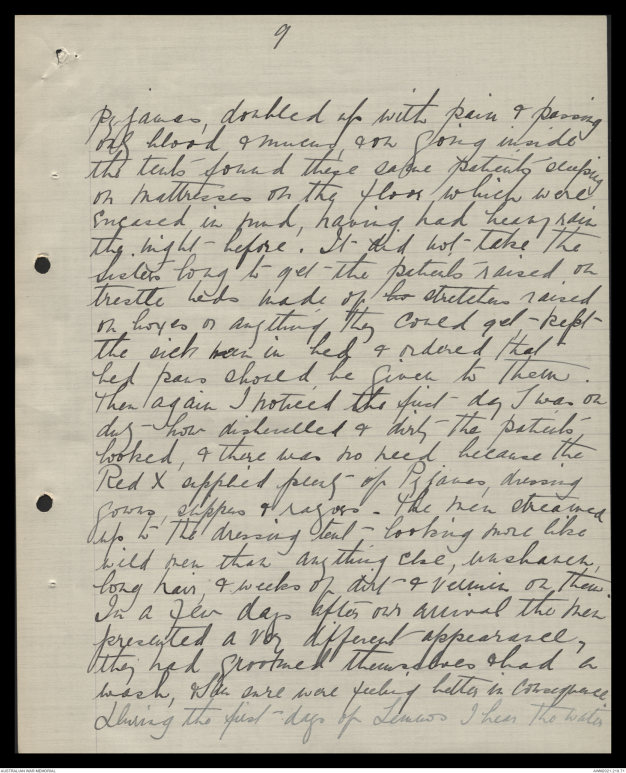
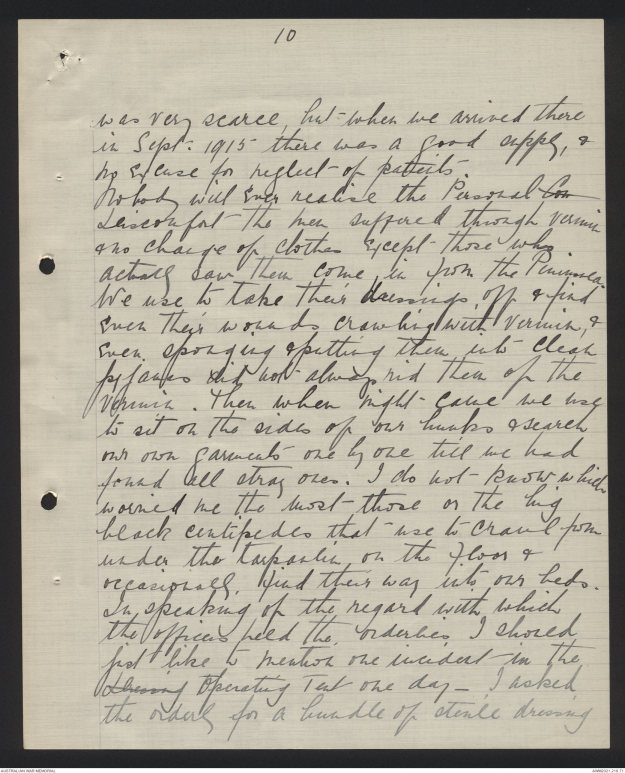
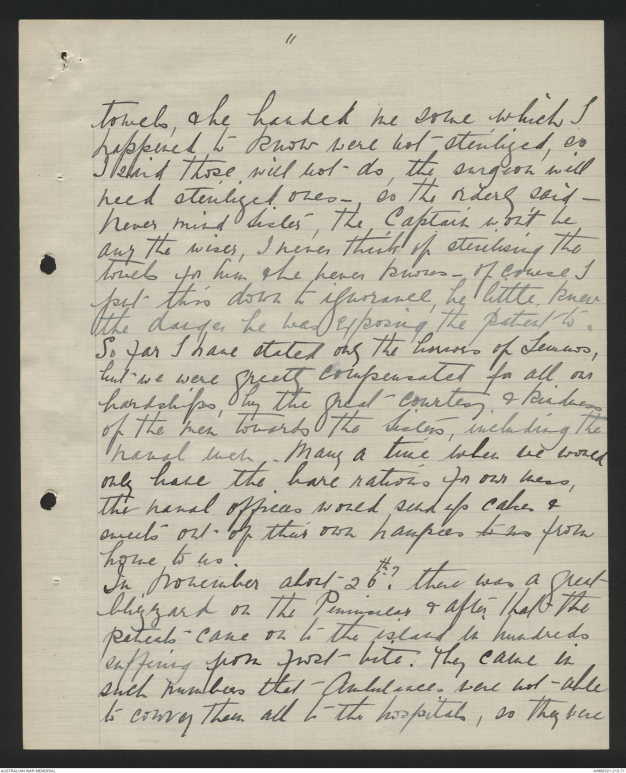
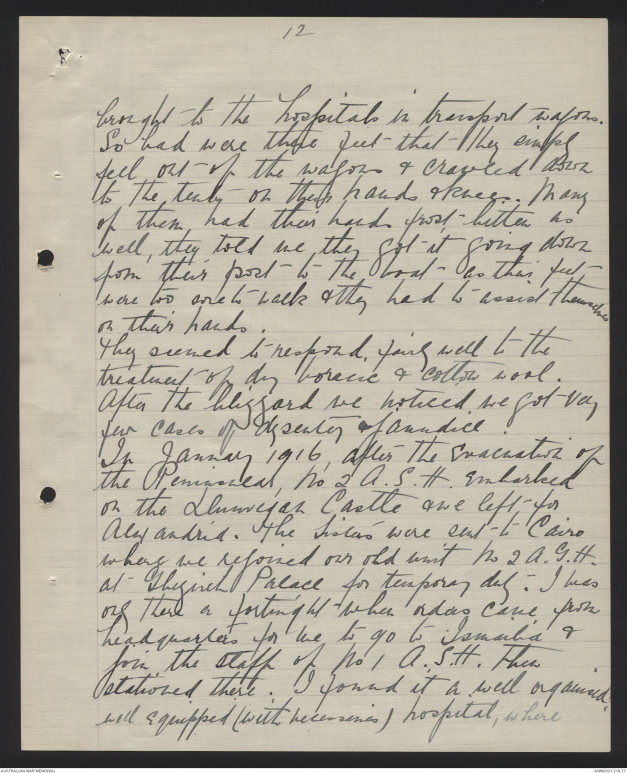
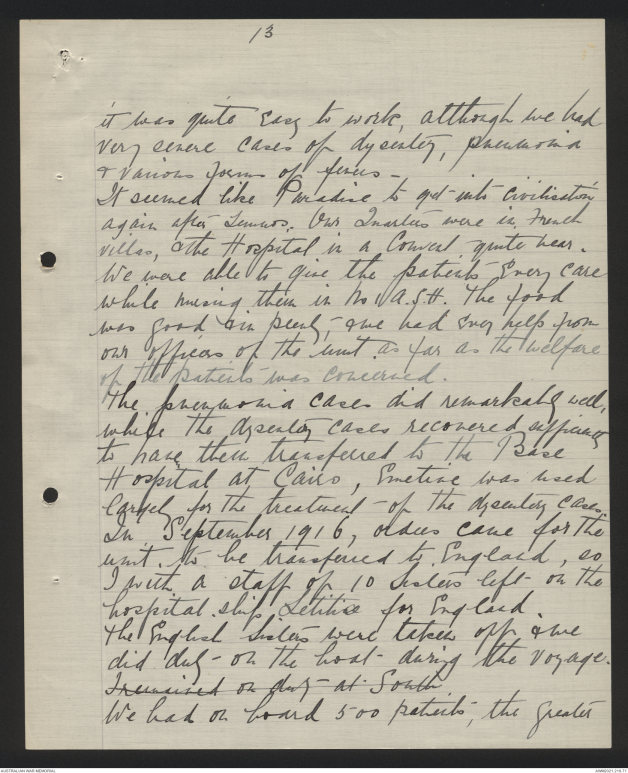
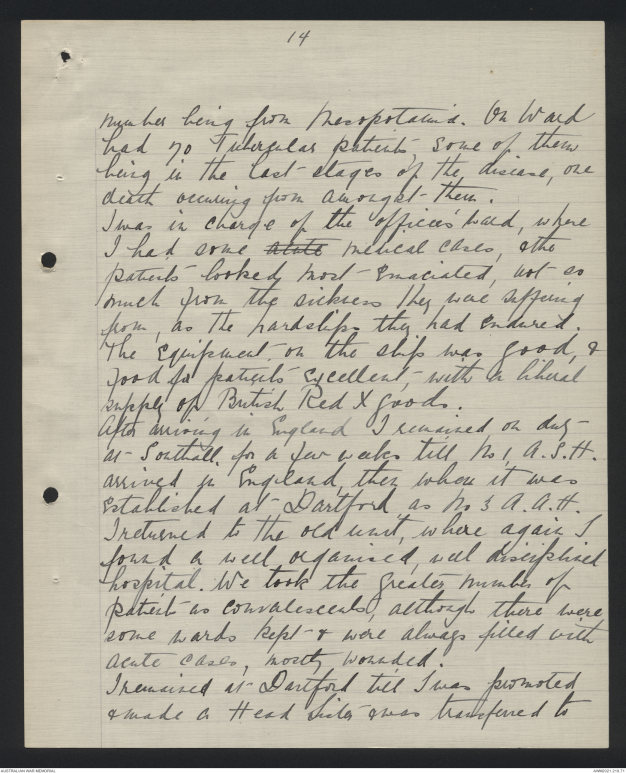
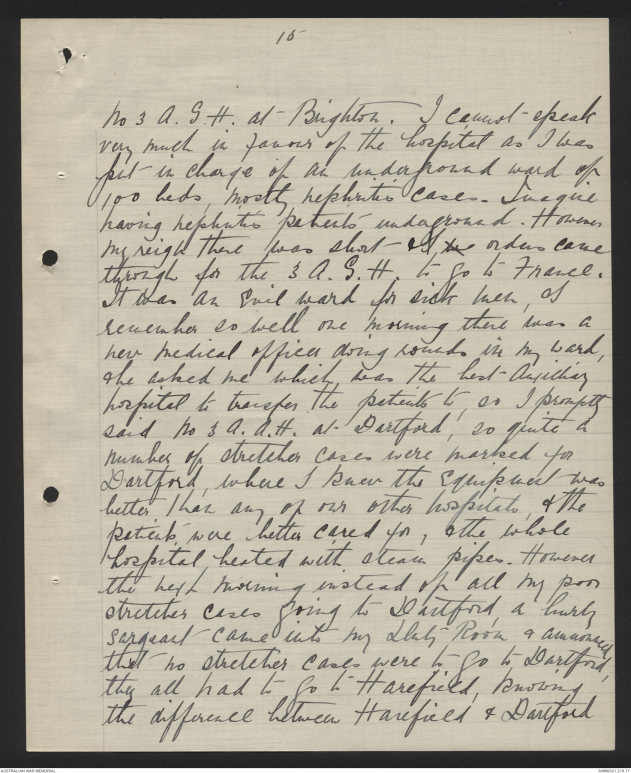
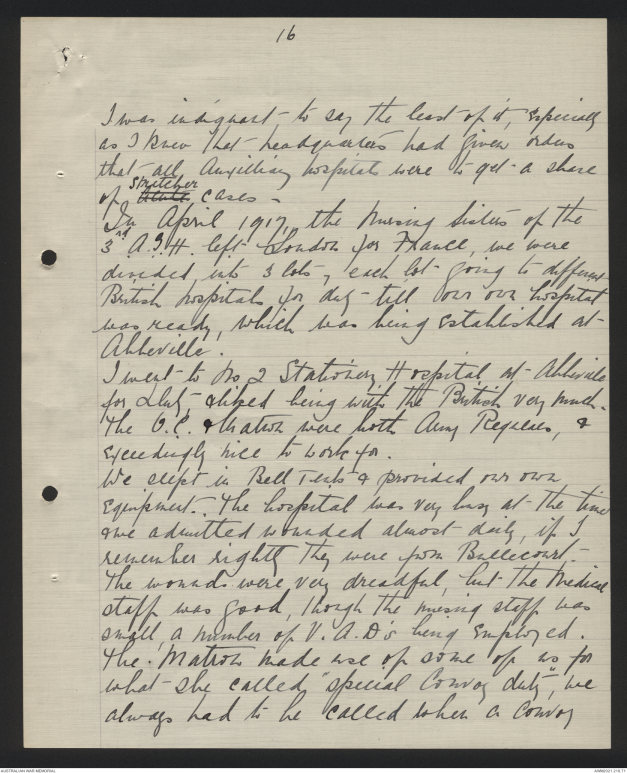
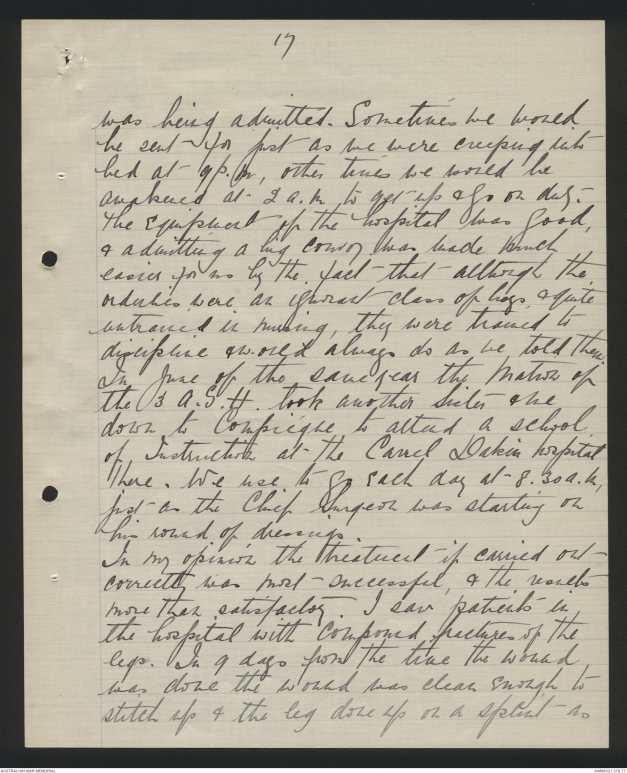
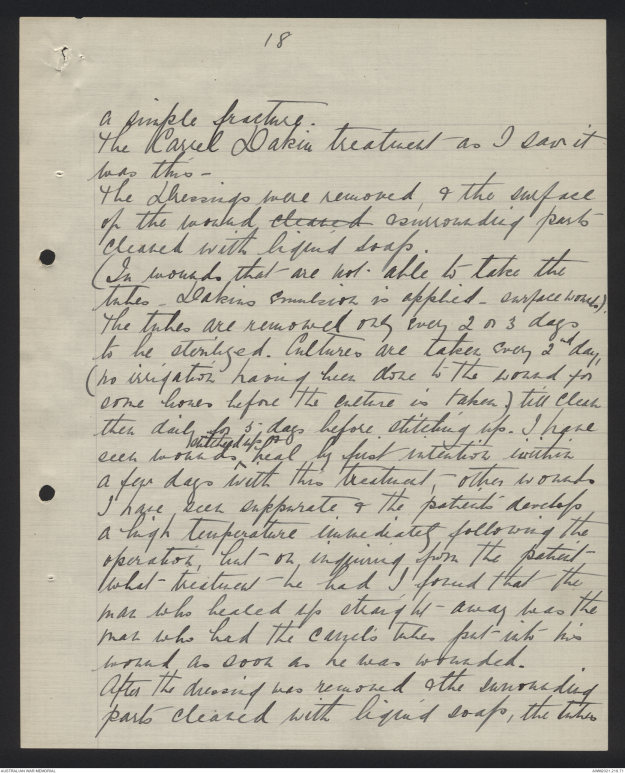
9
pyjamas, doubled up with pain & passing
of blood & mucus, & on going inside
the tents found these same patients sleeping
on mattresses on the floor which were
encased in mud, having had heavy rain
the night before. It did not take the
Sisters long to get the patients raised, on
trestle beds made of he stretchers raised
on boxes or anything they could get kept
the sick men in bed & ordered that
bed pans should be given to them.
Then again I noticed the first day I was on
duty - how dishevelled & dirty the patients
looked, & there was no need because the
Red X supplied plenty of Pyjamas, dressing
gowns, slippers & razors - the men streamed
up to the dressing tent looking more like
wild men than anything else, unshaven,
long hair, & weeks of dirt & vermin on them.
In a few days after our arrival the men
presented a very different appearance,
they had groomed themselves & had a
wash, & I am sure were feeling better in consequence.
During the first days of Lemnos I hear the water
10
was very scarce, but when we arrived there
in Sept. 1915 there was a good supply, &
no excuse for neglect of patients.
Nobody will ever realise the Personal Con
discomfort the men suffered through vermin
& no change of clothes except those who
actually saw them come in from the Peninsula.
We use to take their dressings off & find
even their wounds crawling with vermin, &
even sponging & putting them into clean
pyjamas did not always rid them of the
vermin. Then when night came we use
to sit on the sides of our bunks & search
our own garments one by one till we had
found all stray ones. I do not know which
worried me the most those or the big
black centipedes that use to crawl from
under the tarpaulin on the floor &
occasionally find their way into our beds.
In speaking of the regard with which
the officers held the orderlies, I should
first like to mention one incident in theDressing Operating Tent one day - I asked
the orderly for a bundle of sterile dressing
11
towels, & he handed me some which I
happened to know were not sterilized, so
I said those will not do, the surgeon will
need sterilized ones - so the orderly said -
never mind Sister, the Captain won't be
any the wiser, I never think of sterilising the
towels for him & he never knows - of course I
put this down to ignorance, he little knew
the danger he was exposing the patient to.
So far I have stated only the horrors of Lemnos,
but we were greatly compensated for all our
hardships, by the great courtesy & kindness
of the men towards the Sisters, including the
naval men. Many a time when we would
only have the bare rations for our mess,
the naval officers would send up cakes &
sweets out of their own hampers to us from
home to us.
In November about 26th? there was a great
blizzard on the Peninsular & after that the
patients came on to the island in hundreds
suffering from frost bite. They came in
such numbers that Ambulances were not able
to convey them all to the hospital, so they were
12
brought to the hospital in transport wagons.
So bad were there feet that they simply
fell out of the wagons & crawled down
to the tents on their hands & knees. Many
of them had their hands frost bitten as
well, they told me, they got it going down
from their post to the boat as their feet
were too sore to walk & they had to assist themselves
on their hands.
They seemed to respond, fairly well to the
treatment of dry boracic & cotton wool.
After the blizzard we noticed we got very
few cases of dysentry & jaundice.
In January 1916, after the evacuation of
the Peninsular, No 2 A.G.H. embarked
on the Dunvegan Castle & we left for
Alexandria. The sisters were sent to Cairo
where we rejoined our old unit No 2 A.G.H.
at Ghezireh Palace for temporary duty. I was
only there a fortnight when orders came from
headquarters for me to go to Ismailia &
join the staff of No 1 A.G.H. then
stationed there. I found it a well organised,
well equipped (with necessaries) hospital, where
13
it was quite easy to work, although we had
very severe cases of dysentery, pneumonia
& various forms of fevers.
It seemed like Paradise to get into civilisation
again after Lemnos. Our Quarters were in French
villas, & the Hospital in a Convent, quite near.
We were able to give the patients every care
while nursing them in No 1 .A.G.H. The food
was good & in plenty, & we had every help from
our officers of the unit as far as the welfare
of the patients was concerned.
The pneumonia cases did remarkably well,
while the dysentery cases recovered sufficiently
to have them transferred to the Base
Hospital at Cairo, Emetine was used
largely for the treatment of the dysentery cases.
In September 1916, orders came for the
unit to be transferred to England, so
I with a staff of 10 Sisters left on the
hospital ship, Letitia for England.
The English sisters were taken off & we
did duty on the boat during the voyage.I remained on duty at South
We had on board 500 patients, the greater
14
number being from Mesopotamia. Our Ward
had 70 Tubercular patients, some of them
being in the last stages of the disease, one
death occurring from amongst them.
I was in charge of the officers' ward, where
I had some acute medical cases, & the
patients looked most emaciated, not so
much from the sickness they were suffering
from, as the hardships they had endured.
The equipment on the ship was good, &
food for patients excellent, with a liberal
supply of British Red X goods.
After arriving in England I remained on duty
at Southall for a few weeks till No 1, A.G.H.
arrived in England, then when it was
established at Dartford as No 3 A.A.H.
I returned to the old unit, where again I
found a well organised, well disciplined
hospital. We took the greater number of
patients as convalescents, although there were
some wards kept & were always filled with
acute cases, mostly wounded.
I remained at Dartford till I was promoted
& made a Head Sister & was transferred to
15
No 3 A.G.H. at Brighton. I cannot speak
very much in favour of the hospital as I was
put in charge of an underground ward of
100 beds mostly nephritis cases. Imagine
having nephritis patients underground. However
my reign there was short as xx orders came
through for the 3 A.G.H. to go to France.
It was an evil ward for sick men, & I
remember so well one morning there was a
new medical officer doing rounds in my ward,
& he asked me which was the best Auxillary
hospital to transfer the patients to, so I promptly
said No 3 A.A.H. at Dartford, so quite a
number of stretcher cases were marked for
Dartford, where I knew the equipment was
better than any of our other hospitals, & the
patients were better cared for, & the whole
hospital heated with steam pipes. However
the next morning instead of all my poor
stretcher cases going to Dartford, a burly
Sargeant came into my Duty Room & announced
that no stretcher cases were to go to Dartford,
they all had to go to Harefield, knowing
the difference between Harefield & Dartford
16
I was indignant to say the least of it, especially
as I knew that headquarters had given orders
that all Auxilliary hospitals were to get a share
of acute stretcher cases.
In April 1917, the Nursing Sisters of the
3rd A.G.H. left London for France, we were
divided into 3 lots, each lot going to different
British hospitals for duty till our own hospital
was ready, which was being established at
Abbeville.
I went to No. 2 Stationary Hospital at Abbeville
for Duty & liked being with the British very much.
The O.C. & Matron were both Army Regulars, &
exceedingly nice to work for.
We slept in Bell Tents & provided our own
equipment. The hospital was very busy at the time
& we admitted wounded almost daily, if I
remember rightly they were from Bullecourt.
The wounds were very dreadful, but the Medical
staff was good, though the nursing staff was
small, a number of V.A.D's being employed.
The Matron made use of some of us for
what she called "special Convoy duty", we
always had to be called when a convoy
17
was being admitted. Sometimes we would
be sent for just as we were creeping into
bed at 9p.m, other times we would be
awakened at 2a.m to get up & go on duty.
The equipment of the hospital was good,
& admitting a big convoy was made much
easier for us by the fact that although the
orderlies were an ignorant class of boys, & quite
untrained in nursing, they were trained to
discipline & would always do as we told them.
In June of the same year the Matron of
the 3 A.G.H. took another Sister & me
down to Compiegne to attend a school
of Instruction at the Carrel Dakin hospital
there. We use to go each day at 8.30a.m,
just as the Chief Surgeon was starting on
his round of dressings.
In my opinion the treatment if carried out
correctly was most successful, & the results
more than satisfactory. I saw patients in
the hospital with compound fractures of the
legs. In 9 days from the time the wound
was done the wound was clean enough to
stitch up & the leg done up on a splint as
18
a simple fracture.
The Carrel Dakin treatment as I saw it
was this -
The dressings were removed, & the surface
of the wound cleaned & surrounding parts
cleaned with liquid soap.
(In wounds that are not able to take the
tubes - Dakins emulsion is applied - surface wounds).
The tubes are removed only every 2 or 3 days
to be sterilized. Cultures are taken every 2nd day,
(no irrigation having been done to the wound for
some hours before the culture is taken) till clean
then daily for 5 days before stitching up. I have
seen wounds ^stitched up & heal by first intention within
a few days with this treatment, other wounds
I have seen suppurate & the patient develops
a high temperature immediately following the
operation, but on inquiring from the patient
what treatment he had I found that the
man who healed up straight away was the
man who had the Carrel's tubes put into his
wound as soon as he was wounded.
After the dressing was removed & the surrounding
parts cleaned with liquid soap, the tubes
 Jasmine Hatharasinghe
Jasmine HatharasingheThis transcription item is now locked to you for editing. To release the lock either Save your changes or Cancel.
This lock will be automatically released after 60 minutes of inactivity.